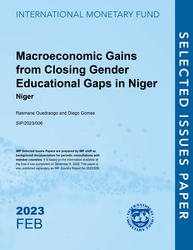
Macroeconomic Gains from Closing Gender Educational Gaps in Niger: Niger
This paper explores the state of gender equality and education attainment of girls in Niger. It also estimates the macroeconomic gains from reducing gaps in education between boys and girls using a micro-founded general equilibrium model.
READ MORE...
Volume/Issue:
Volume 2023
Issue 006
Publication date: February 2023
ISBN: 9798400235207
$15.00
Add to Cart by clicking price of the language and format you'd like to purchase
Available Languages and Formats
| English |
Prices in red indicate formats that are not yet available but are forthcoming.
Topics covered in this book
This title contains information about the following subjects.
Click on a subject if you would like to see other titles with the same subjects.
Money and Monetary Policy , Public Finance , International - Economics , Gender Studies , Gender , Education , Gains , increase income , income percentile , macroeconomic gain , Sahel region , income spectrum , Gender inequality , Women , Education spending , Sub-Saharan Africa
Summary
This paper explores the state of gender equality and education attainment of girls in Niger. It also estimates the macroeconomic gains from reducing gaps in education between boys and girls using a micro-founded general equilibrium model. The analysis shows that Niger has made some progress toward higher educational attainment for girls, but the country still lags far behind other sub-Saharan African countries. The results from the general equilibrium model suggest that closing the gender gaps in education would boost female labor participation, increase income earned by women and improve fiscal outcomes. More importantly, closing the gender gap in years of schooling in each income percentile would boost long-term GDP by 11 percent. These significant economic gains from investing in girls’ education will contribute to the achievements of the strategic goals defined under the Programme de Développement Economique et Social (PDES) 2022-26.
Copyright © 2010 - 2025
Powered by:
AIDC



